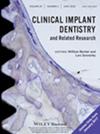A 6-Year Randomized Controlled Trial on Different Implant Designs in Maxillary Overdenture Patients
Abstract
Background
In order to reduce crestal bone remodeling around the implant shoulder, different implant macrodesigns have been developed. The presence of microthreads at the coronal part of the implant, as well as platform-shifting using a conical internal abutment connection, is suggested to limit bone remodeling. However, long-term studies excluding confounding factors to confirm this are scarce.
Aim
This randomized controlled trial aimed to assess the effect of implant neck design (microthreaded vs. non-microthreaded) as well as type of abutment connection (internal conical vs. external flat-to-flat) on long-term crestal bone remodeling and peri-implant health. Additionally, the clinical outcome of bar-retained maxillary overdentures on 4 implants is reported after at least 6 years of function.
Materials and Methods
Twenty-five patients were treated with a bar-retained maxillary overdenture. Each patient received 4 different implants, one of each of the 4 experimental designs, with respectively: internal connection and microthreads on the implant neck (I MT); internal connection without microthreads (I NMT); external connection with microthreads (E MT); and external connection without microthreads (E NMT). Other features, such as diameter, surface topography, extent of platform switch, as well as the surgical and prosthetic treatment protocol, were identical. The implants were randomly allocated to the sites (posterior right, anterior right, anterior left, and posterior left), based on a pre-randomized, fixed-order assignment generated by a randomization software. Radiographic crestal bone loss (CBL), plaque score (PS), bleeding on probing (BoP) and probing pocket depth (PPD) were determined after 1 and 6 function years.
Results
Two implants in 2 patients were excluded because of protocol deviations, requiring the placement of a wider implant. Four out of 98 implants (4.1%) failed during the provisionalization process. These were replaced with the same type of implant after 3 months of healing and were included in further analysis. Due to the relatively small sample size and high drop-out rate, the effect of microthread design and connection on implant survival could only be reported descriptively. Twenty patients could be re-evaluated at the 1-year and 6-year time points, resulting in 78 examined implants. These showed a mean CBL of 0.39 mm (SD: 0.68; range: 0–3.42) after 1 year and 0.37 mm (SD: 0.61; range: −0.34—3.03) after 6 years. Between the 4 different study implants, no statistically significant difference in CBL could be identified over time. Neither microthreads nor connection type showed a statistically significant effect on CBL over time, nor on PPD, BoP, and PS at the 6-year re-evaluation.
Conclusion
Six years after implant placement, a four-implant, bar-retained maxillary overdenture shows a high implant and prosthetic survival rate with crestal bone stability. The presence or absence of microthreads and the type of implant-abutment connection have only a limited effect on peri-implant CBL. The peri-implant health parameters are indicative of the absence of peri-implantitis.
Trial Registration
ClinicalTrials.gov Identifier: NCT06821308

 求助内容:
求助内容: 应助结果提醒方式:
应助结果提醒方式:


